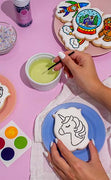
Craters in Royal Icing: How to Avoid Them Completely
Craters are THE WORST. You can flood your snowman cookie perfectly, and then BAM—the eyeballs and carrot nose you just added have sunken in and look terrible. So completely frustrating! And the worst part about craters is that although there are lots of anecdotal solutions for how to prevent them, you won't know if you have succeeded until your cookies are left to dry for a while. You really just have to hold your breath, cross your fingers and toes, and hope the Cookie Gods are with you that day. But this blog isn’t about how to prevent craters (that’s for a different post entirely!). Instead, let’s look at some options you can take to simply avoid the possibility of craters altogether.

"Why is this happening to me?!?!" --Every cookier who has ever dealt with craters in their icing


Why does cratering happen?
Cratering occurs when air bubbles get trapped inside the icing as it is being applied to the cookie. As the icing dries and hardens, these air bubbles expand and create small craters on the surface of the icing.
Keep reading to learn my tips for avoiding craters in your cookies completely.
Wet-on-Wet
Let’s take the example of a snowman cookie, with his eyes, carrot nose, and buttons. One option is always to add those extra details in the wet-on-wet stage. This eliminates the possibility of craters, since the details will be level with the flood icing. Simply flood your snowman and then immediately add the eyeballs, buttons, and carrot nose in a matching-consistency icing. A gentle nudge with your scribe tool can help everything settle into place.
Edible Markers and Paints
Along the same lines as the wet-on-wet technique, drawing on your details with edible marker or paint eliminates the possibility of those areas developing craters. Simply wait until your icing is 100% dry so that you can write on it without accidentally pushing through with the tip of your marker (and even then, try to press carefully!).

Edible markers and paints come in all the colors of the rainbow, so this is an easy work-around for not running into frustrating craters in your icing.
Royal Icing Transfers
If you still want that 3D look to your cookies but don’t want to risk craters, then icing transfers are the way to go. Print out the size and shape of the design you want (this is the best way for you to be consistent), and place it under a sheet of acetate or parchment paper. Alternatively, you could purchase pre-designed transfer sheets that are fun and easy to use and come with a sheet of acetate included.
Simply pipe your designs onto the parchment or acetate, allow the transfers to dry completely, and then carefully remove them from their sheets. Attach to your cookie with a dab of royal icing, and you are all set! If one doesn't turn out the way you hoped, simply don't use it--no worrying about "ruining" a cookie if things go wonky.
These techniques can also easily be used together on the same cookie! Wet-on-wet eyes, marker-drawn arms and mouth, and royal icing transfers for a hat, nose, and buttons can make for a sweet snowman—while allowing you to stress a little less about whether or not craters are going to ruin your day.
Recommended for You:
Piping Bag Tip Tube Covers - Set of 4
AtecoDon't let your icing bags leak or dry out! Use these covers on bags with Ateco couplers and standard tips on them. Reuse them again and again. Se...
View full detailsBlack Fine Tip Food Marker
The Cookie CountessA black edible-ink pen is essential for your decorating kit. Use these high quality markers for: Marking up baked cookies for planning designs Wr...
View full detailsStainless Steel Measuring Cups 4 Piece Set
The Cookie CountessIncredibly high quality, with no plastic parts. Whether baking or cooking you'll reach for these essentials again and again! THESE ARE THE LAST SET...
View full detailsCookie Order Form 5 x 7, 50 sheets
The Cookie CountessThese cute sheets will help you plan your cookie orders. The back has an area for sketching and pricing planning. Size: 5" x 7" 50 Sheet Pad Doub...
View full details-

Introducing the Cookie Countess Cookie Capsule Collection!
Read nowTired of using boring clear bags as packaging for your beautiful decorated cookies? Or maybe you’ve been looking for a more protective way to package them that is just as pretty as the cookies themselves? Well, look no further than...
-

Stamped Jack-o-Lantern Cookies: an Easy Halloween Treat
Read nowSo you want to make Halloween cookies, but you don't really feel like making or using royal icing? Well, do we have the design for you! Look no further than the Cookie Countess Jack-O-Lantern cutter and stamps set to help...
-

Make and Decorate Easy Mini Jack-o-Lantern Cookies
Read nowHalloween is one of the biggest cookie holidays of the year, and I personally think that can be chalked up to the sheer number of fun/spooky/adorable/creepy designs this holiday lends itself to! Let's look at one of the most basic--Jack-o-Lanterns!...

















Leave a comment